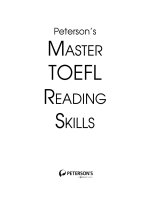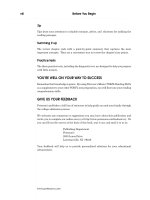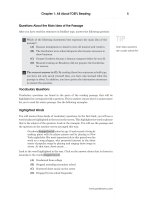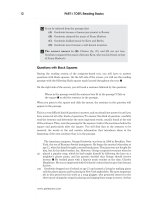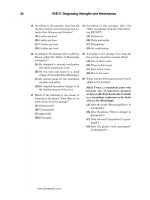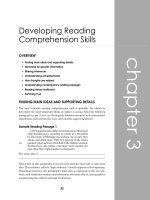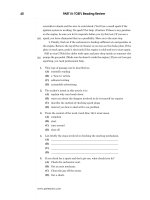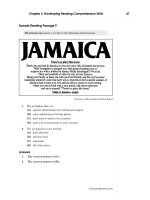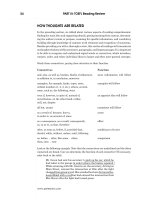Peterson’s master toefl reading skills part 20 pdf
Bạn đang xem bản rút gọn của tài liệu. Xem và tải ngay bản đầy đủ của tài liệu tại đây (73.17 KB, 7 trang )
124 PART IV: Two Practice Tests
www.petersons.com
2. Which of the following is the closest in
meaning to the word “vaccine” as used in
line 3 of the passage?
(A) Medicine designed to cure a disease
temporarily
(B) Medicine that cures a disease after
the patient gets sick
(C) Medicine designed to kill viruses that
are fatal to children
(D) Medicine that creates immunity
against a disease
3. In the first paragraph, what was Thomas
Francis Jr. studying?
(A) How to prevent the spread of influ-
enza in Michigan
(B) How to work with physicians from
Manhattan
(C) How to develop vaccines from killed
viruses
(D) How to get a degree in medicine from
New York University
4. Which sentence in the second paragraph
describes Salk’s first work at the Univer-
sity of Pittsburgh?
(A) The first sentence
(B) The second sentence
(C) The third sentence
(D) None of the above.
5. Which word is closest in meaning to the
word “corroborated” as used in line 22 of
the passage?
(A) Rejected
(B) Published
(C) Examined
(D) Confirmed
6. All of the following statements about the
killed virus vaccine are true EXCEPT:
(A) it did not induce antibody formation
in monkeys
(B) it had three strains that scientists
worked with
(C) it was incapable of producing the
disease
(D) it helped monkeys form antibodies
7. Look at the word “findings” in line 35.
Which of the following words or phrases
from the previous sentence does the word
“findings” refer to?
(A) Results
(B) Antibody levels
(C) Vaccine
(D) Polio
8. From the passage, it can be inferred that
the experimental polio vaccine was given
to people by
(A) pill
(B) injection
(C) surgery
(D) liquid
9. In the passage, it is implied that the Salk
Institute was
(A) originally called the Institute for Bio-
logical Studies
(B) originally the University of Michigan
School of Public Health
(C) originally the Virus Research Labo-
ratory at the University of Pittsburgh
(D) originally the medical school at New
York University
10. Where in the passage could the following
sentence best fit?
Thousands of children and adults
were free from the fears of contract-
ing this terrible disease.
(A) At the end of paragraph 1
(B) At the end of paragraph 2
(C) At the end of paragraph 3
(D) At the end of paragraph 4
06_TOEFL Reading,Ch 4,121-134 7/29/06, 12:03124
Practice Test 3 125
practice test 3
www.petersons.com
QUESTIONS 11–20 REFER TO THE
FOLLOWING PASSAGE.
The word synthesize means to produce
by combining separate elements. Thus,
synthesized sound is sound that a mu-
sician builds from component elements.
A synthesized sound may resemble a
traditional acoustic musical timbre, or
it may be completely novel and origi-
nal. One characteristic is common to all
synthesized music, however. The sound
qualities themselves, as well as the
relationships among the sounds, have
been “designed,” or “composed,” by a
musician.
Many people believe that synthesized
music imitates traditional musical in-
struments and ensembles. They believe
that synthesized music is created me-
chanically without control by a musi-
cian. These ideas are not true.
A builder of a traditional musical in-
strument assembles a collection of acous-
tic elements whose interrelationships
cannot change. For example, a violin
has four strings positioned over a finger-
board and coupled through the bridge to
the violin’s body. Violinists bring the
strings into contact with the fingerboard
and a bow to cause the strings to vibrate.
The resultant sound is resonated by the
hollow body of the violin. However, vio-
linists do not change the relationship of
the strings to the bridge, nor that of the
bridge to the body. Nor, do they
reconfigure its slightly hour-glass shape.
Synthesists, on the other hand, view
their instrument as a collection of parts
that they configure to produce the sounds
they want. They call this “programming,”
or “patching,” and they may do this be-
fore or during performance. The parts
that synthesists work with depend on
the design of the instruments that they
are using. In general, synthesizers in-
clude elements that generate and com-
bine waveforms and that shape loudness
of the sounds. Other sound-producing
and -processing elements, which can
exist as electronic circuits or as built-in
computer programs, may also be avail-
able. To control these elements, a syn-
thesist may use a combination of a con-
ventional keyboard and other manual
control devices, such as wheels, sliders,
and joysticks.
11. Which answer choice is closest in meaning
to the word “resemble” as used in line 5?
(A) Recreate
(B) Put together
(C) Sound like
(D) Take apart
12. According to the passage, what do compo-
nent elements of synthesizers include?
(A) Computer programs and hollow bodies
(B) Bridges and electronic circuits
(C) Fingerboards and patchers
(D) Computers and electronic keyboards
13. It can be inferred from the passage that
many people
(A) dislike synthesized music because it
lacks harmony and beauty
(B) enjoy imitating the sounds of musical
instruments
(C) build musical instruments in their
home
(D) believe that synthesized music is cre-
ated by a machine, not by a musician
14. According to the passage, the interrela-
tionships of acoustical elements in tradi-
tional musical instruments
(A) comprise wood and horsehair
(B) cannot be changed
(C) resonate musical notes
(D) resemble an hour glass
15. Which answer choice is the closest in
meaning to the word “coupled” as used in
line 25?
(A) Connected
(B) Performed
(C) Folded
(D) Vibrated
(5)
(10)
(15)
(20)
(25)
(30)
(35)
(40)
(45)
(50)
06_TOEFL Reading,Ch 4,121-134 7/29/06, 12:03125
126 PART IV: Two Practice Tests
www.petersons.com
16. All of the following contribute to the sound
of a violin EXCEPT:
(A) a bridge
(B) a fingerboard
(C) a keyboard
(D) a bow
17. Where in the passage would the following
sentence best fit?
This, in turn, vibrates the air and
sends the sound to the listener’s ears.
(A) After the word “original” in the first
paragraph
(B) After the word “ensembles” in the
second paragraph
(C) After the phrase “hollow body of a
violin” in the third paragraph
(D) At the end of the fourth paragraph
18. The word “its” as used in line 34 refers to
which of the following words or phrases
from the preceding sentence?
(A) Violinists
(B) Strings
(C) The body
(D) The bridge
19. What is the main idea of the passage?
(A) Synthesized music is loved by everyone
who enjoys rock and popular music.
(B) Synthesized music is used mostly in
film and TV.
(C) Synthesized music combines separate
elements and changes the relation-
ships of those elements.
(D) Synthesized music cannot resemble
traditional musical instruments.
20. According to the passage, what are wheels,
sliders, and joysticks?
(A) Relationships among elements
(B) Parts of computer game boards
(C) Manual control devices on sound syn-
thesizers
(D) Sound qualities designed by a syn-
thesist
QUESTIONS 21–30 REFER TO THE
FOLLOWING PASSAGE.
The New York Times is a daily newspa-
per published in New York City. For a
long time, it has been the newspaper of
record in the United States and one of
the world’s great newspapers. Its
strength is in its editorial excellence; it
has never been the largest newspaper in
terms of circulation.
The Times was established in 1851 as
a penny paper whose editors wanted to
report the news in a restrained and
objective fashion. It enjoyed early suc-
cess as its editors set a pattern for the
future by appealing to a cultured, intel-
lectual readership instead of a mass
audience. However, in the late nine-
teenth century, it came into competition
with more popular, colorful, if not lurid,
newspapers in New York City. Despite
price increases, the Times was losing
$1,000 a week when Adolph Simon Ochs
bought it in 1896.
Ochs built the Times into an interna-
tionally respected daily. He hired Carr
Van Anda as editor. Van Anda placed
greater stress than ever on full report-
ing of the news of the day, and his
reporters maintained and emphasized
existing good coverage of international
news. The management of the paper
decided to eliminate fiction from the
paper, added a Sunday magazine sec-
tion, and reduced the paper’s price back
to a penny. In April 1912, the paper took
many risks to report every aspect of the
sinking of the Titanic. This greatly en-
hanced its prestige, and in its coverage
of two world wars, the Times continued
to enhance its reputation for excellence
in world news.
In 1971, the Times was given a copy of
the so-called “Pentagon Papers,” a se-
cret government study of U.S. involve-
ment in the Vietnam War. When it
published the report, it became involved
in several lawsuits. The U.S. Supreme
Court found that the publication was
protected by the freedom-of-the-press
clause in the First Amendment of the
(5)
(10)
(15)
(20)
(25)
(30)
(35)
(40)
(45)
06_TOEFL Reading,Ch 4,121-134 7/29/06, 12:03126
Practice Test 3 127
practice test 3
www.petersons.com
U.S. Constitution. Later in the 1970s,
the paper, under Adolph Ochs’s grand-
son, Arthur Ochs Sulzberger, introduced
sweeping changes in the organization of
the newspaper and its staff and brought
out a national edition transmitted by
satellite to regional printing plants.
21. What is the main idea of the passage?
(A) The New York Times publishes the
best fiction by American writers.
(B) The New York Times became highly
respected throughout the world.
(C) The New York Times broadcasts its
news to TV stations via satellite.
(D) The New York Times lost its prestige
after the Vietnam War.
22. It can be inferred from the passage that
the circulation of the Times is
(A) not the largest in the world.
(B) not the best in the world.
(C) the smallest in the world.
(D) the worst in the world.
23. Which phrase is closest in meaning to the
word “restrained” as it is used in line 11?
(A) Put in prison
(B) In handcuffs
(C) Without education
(D) With self-control
24. According to the passage, what caused
the loss of money at the Times?
(A) Other newspapers were more colorful.
(B) Other newspapers had better reporters.
(C) Other newspapers added a Sunday
magazine.
(D) Other newspapers were better
managed.
25. What word or phrase does the word “his”
as used in line 27 refer to?
(A) Van Anda
(B) Reporters
(C) News of the day
(D) International news
26. Where can the following sentence best be
added to the passage?
Their publishers ran sensational sto-
ries, not because they were true, but
because they sold newspapers.
(A) At the end of the first paragraph
(B) After the word “City” in the second
paragraph
(C) At the end of the third paragraph
(D) After the phrase “lawsuits” in the
fourth paragraph
27. To improve its circulation, the manage-
ment of the Times did all of the following
EXCEPT:
(A) emphasized good coverage of interna-
tional news
(B) added a Sunday magazine section
(C) increased the number of lurid stories,
even if they were not true
(D) eliminated fiction from the paper
28. The passage implies that the newspaper’s
reputation
(A) decreased when it lowered its price to
a penny
(B) grew because Adolph Ochs bought it
in 1896
(C) increased because of its coverage of
the Titanic’s sinking
(D) decreased because it could not com-
pete with other New York papers
(50)
(55)
06_TOEFL Reading,Ch 4,121-134 7/29/06, 12:03127
128 PART IV: Two Practice Tests
www.petersons.com
29. What word or phrase does the word “pub-
lication” as used in line 47 refer to?
(A) The Times
(B) “The Pentagon Papers”
(C) The Report
(D) The Constitution
30. According to the passage, the Times has a
national edition that is
(A) protected by the Supreme Court
(B) printed in the form of a Sunday
magazine
(C) shipped by train and air transport
daily
(D) transmitted by satellite to regional
printing plants
QUESTIONS 31–40 REFER TO THE
FOLLOWING PASSAGE.
Pittsburgh, Pennsylvania, is located
where the Allegheny and Monongahela
rivers unite to form the Ohio River. Its
fascinating history began in 1758 when
General John Forbes and his British
and colonial army captured Fort
Duquesne from the French and renamed
it Fort Pitt, for the British statesman
William Pitt the Elder. After an agree-
ment between the Native American
tribes and William Penn’s family, set-
tlers began arriving. Pittsburgh was laid
out (1764) by John Campbell in the area
around the fort.
Following the American Revolution,
the town became an outfitting point for
settlers traveling westward down the
Ohio River. Pittsburgh’s strategic loca-
tion and wealth of natural resources
spurred its commercial and industrial
growth in the nineteenth century. A
blast furnace, erected by George
Anschutz about 1792, was the forerun-
ner of the iron and steel industry that for
more than a century was the city’s eco-
nomic power. By 1850, it was known as
the “Iron City.” The Pennsylvania Canal
and the Portage Railroad, both com-
pleted in 1834, opened vital markets for
trade and shipping.
After the American Civil War, great
numbers of European immigrants
swelled Pittsburgh’s population, and
industrial magnates such as Andrew
Carnegie, Henry Clay Frick, and Tho-
mas Mellon built their steel empires
there. The city became the focus of his-
toric friction between labor and man-
agement, and the American Federation
of Labor was organized there in 1881. By
1900, the city’s population had reached
321,616. Growth continued nearly un-
abated through World War II, and dur-
ing the war years, Pittsburgh was a
boom town.
During this period of economic and
population growth, Pittsburgh became
a grimy, polluted industrial city. After
the war, however, the city undertook an
extensive redevelopment program, with
emphasis on smoke-pollution control,
flood prevention, and sewage disposal.
In 1957, it became the first American
city to generate electricity by nuclear
power. By the late 1970s and early 80s,
the steel industry had virtually disap-
peared, but Pittsburgh successfully di-
versified its economy through more
emphasis on light industries and on such
high-technology industries as computer
software, industrial automation (robot-
ics), and biomedical and environmental
technologies.
31. In the mid-eighteenth century, what two
countries wanted to control the area now
known as Pittsburgh?
(A) England and the United States
(B) England and France
(C) England and Germany
(D) England and Pennsylvania
(5)
(10)
(15)
(20)
(25)
(30)
(35)
(40)
(45)
(50)
(55)
(60)
06_TOEFL Reading,Ch 4,121-134 7/29/06, 12:03128
Practice Test 3 129
practice test 3
www.petersons.com
32. When did settlers begin arriving in
Pittsburgh?
(A) After an agreement between the Indi-
ans and the Penn family
(B) After the Allegheny and Monongahela
rivers united
(C) After the British captured Fort Pitt
(D) After the American Revolution
33. Which phrase is closest in meaning to the
phrase “outfitting point” as used in line
16?
(A) A store that sells gasoline and oil
(B) A location of food and water
(C) A place to buy business suits and
accessories
(D) A source of equipment and supplies
34. What became the most important indus-
try in Pittsburgh following the American
Revolution?
(A) The shipping industry
(B) The iron and steel industry
(C) The outfitting industry
(D) The computer software industry
35. Which of the following phrases is closest
in meaning to the phrase “vital markets”
as used in line 29?
(A) Hospitals and medical centers
(B) Large stores for food and clothing
(C) Places with customers for Pittsburgh’s
products
(D) Native American tribes and military
forts
36. According to the passage, who moved to
Pittsburgh in great numbers after the
Civil War?
(A) Native American tribes
(B) British soldiers
(C) Confederate veterans
(D) European immigrants
37. Which of the following phrases is closest
in meaning to the phrase “focus of historic
friction” as used in lines 37–38?
(A) Center of an important conflict
(B) Museum for historical photographs
(C) Famous furniture factory
(D) City of many professional sports
38. According to the passage, what can be
inferred about Pittsburgh’s population
during World War II?
(A) It did not grow.
(B) It declined.
(C) It grew enormously.
(D) It stayed the same.
39. Between the Civil War and World War II,
all of the following happened in Pitts-
burgh EXCEPT:
(A) automobile factories produced most
of the transportation for Americans
(B) Carnegie, Frick, and Mellon created
their steel empires
(C) the American Federation of Labor
was organized
(D) the air became seriously polluted, and
buildings were dirty
40. Where in the passage could the following
sentence best fit?
The elder Penn, who lived in Phila-
delphia, believed that peaceful settle-
ments with the Indians would help
his young colony prosper.
(A) After the word “arriving” in the first
paragraph
(B) After the words “Ohio River” in the
second paragraph
(C) At the end of the third paragraph
(D) After the words “polluted industrial
city” in the fourth paragraph
06_TOEFL Reading,Ch 4,121-134 7/29/06, 12:03129
130 PART IV: Two Practice Tests
www.petersons.com
QUESTIONS 41–50 REFER TO THE
FOLLOWING PASSAGE.
The Missouri River is the longest tribu-
tary of the Mississippi River, and it
begins its trip to join the Mississippi in
the Rocky Mountains in Montana. The
Missouri flows eastward to central North
Dakota, where it turns southward across
South Dakota, Nebraska, and Iowa.
When it reaches Missouri, it turns east-
ward at Kansas City and meanders
across central Missouri to join the Mis-
sissippi River, about 10 miles north of
St. Louis, after traveling 2,315 miles.
Its drainage basin occupies about
529,400 square miles of the Great Plains.
Elevations within its basin are extreme:
from 14,000 feet above sea level in the
Rockies near the Continental Divide to
400 feet where it joins the Mississippi.
The flow of the Missouri changes fre-
quently from 4,200 cubic feet per second
to 900,000 cubic feet per second.
Its mouth was discovered in 1673 by
the French explorers Jacques Marquette
and Louis Joliet while they were canoe-
ing down the Mississippi River. In the
early 1700s, French fur traders began to
navigate upstream. The first explora-
tion of the river from its mouth to its
headwaters was made in 1804–05 by
Meriwether Lewis and William Clark.
For many years, the river was, except for
fur traders, little used by the earliest
American settlers moving west. The
American Fur Company began to use
steamers on the river in 1830 but began
to decline in the following year with the
completion of the Hannibal and St. Jo-
seph Railway to St. Joseph, Missouri.
For the first 150 years after settlement
along the river, the Missouri was not
developed as a useful waterway or as a
source of irrigation and power. In 1940,
a comprehensive program was started
for flood control and water-resource de-
velopment in the Missouri River basin.
The Fort Peck Dam is one of the largest
earthfill dams in the world. The entire
system of dams and reservoirs has
greatly reduced flooding on the Missouri
and provides water to irrigate millions
of acres of farmland. Electricity for many
communities is generated along the
river’s upper course.
41. In which state does the Missouri begin its
trip to the Mississippi?
(A) Iowa
(B) South Dakota
(C) North Dakota
(D) Montana
42. Which of the following is closest in meaning
to the word “meanders” as used in line 9?
(A) Is harsh to the land it is in
(B) Follows a winding and turning course
(C) Causes a lot of damage with floods
(D) Flows slowly and gently
43. The passage implies that the elevation of
the Missouri River’s drainage basin
(A) remains level throughout the trip from
Montana through Missouri
(B) rises almost 2,315 feet
(C) changes frequently
(D) drops more than 13,000 feet between
the Rocky Mountains and its mouth
on the Mississippi
44. Which of the following is the closest in
meaning to the word “mouth” as it is used
in line 22?
(A) Entrance to a harbor, valley, or cave
(B) The opening of a container
(C) Part of a river that flows into a lake or
ocean
(D) Oral cavity
(5)
(10)
(15)
(20)
(25)
(30)
(35)
(40)
(45)
(50)
06_TOEFL Reading,Ch 4,121-134 7/29/06, 12:03130
